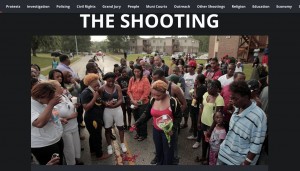
Editor’s Note: This article is part of Storybase, a series of occasional articles exploring new forms of interactive storytelling.
The first moments of an interactive on street harassment by the Fusion media company features a somber grid of 76 black and white pictures of women and a few men.
Once a user clicks, the photo enlarges into a video where a person reveals, in detail, the types of catcalls that ricochet through the streets of Mexico City. Some women showed signs of embarrassment, laughing nervously or quickly darting their eyes away from the camera as they described the inappropriate words they hear so often. Others showed hints of of anger as they described how they were touched.
“Wow, you’ve got a nice butt, little mamma” or “I’m going to take advantage of you while you’re still young” were just a couple of the catcalls the women mentioned.
The photo grid was just one element of Fusion’s interactive story called, “All the Time. Every Day.” The story documents the city’s issue of street harassment and the efforts of one artist, Tatyana Fazlalizadeh, of Brooklyn, who has a public art project called Stop Telling Women to Smile. The ongoing project works to combat gender-based street harassment by “creating a bold presence for women in an environment where they are so often made to feel uncomfortable and unsafe,” according to the artist’s website. Fusion producers commissioned Fazlalizadeh to make the project come to life both in Mexico City and online.
The story follows Fazlalizadeh as she interviewed women and drew their portraits with captions of what they wanted to convey to their harassers. With Fusion’s help, she plastered posters of seven women throughout the city, she wrote on Tumblr. In one poster, a woman has a serious face with the words “Yo Merezco Ser Respetada,” meaning “I deserve to be respected.” The team used creative methods to document the project for the interactive.
The Fusion team tried novel approaches to document the project.
In one instance, the team placed a Go-Pro camera behind an eye on a portrait to capture people’s reactions. The viewer can see through the eye cutout as the poster stops people in their tracks. Interestingly, most of them do not stare the woman’s portrait in the eyes; their eyes move below to the caption.
All told, the project took more than five months and more than a dozen people to complete. They interviewed women and men in Mexico City to research the issue of catcalls.
Fusion, which launched in 2013, declined to reveal how much it spent to produce the project. The company also did not release analytics.
Below is an edited interview with Anna Holmes, the executive producer of the interactive.
American Journalism Review: How does the interactive format alter the nature of the story?
Anna Holmes: [I] felt that the story had so many different elements to it and that some elements would be better served by having, let’s say, video [or still photos or text]. The only way I could bring all those together was to put it in an interactive format.
AJR: Why did you choose to put a collection of videos at the beginning of the interactive?
Holmes: The number of women in that mosaic/gallery…underscores that [street harassment] is a pervasive problem and that it’s widespread… which also underscores the fact that the title is called, “All the time. Every day.” [The faces are] kind of demanding to be recognized.
AJR: Can you tell me how much work and how many resources were consumed to make the story?
Holmes: There were a couple of us planning the actual trip, and then once we got [to Mexico City] there were…a lot of human resources consumed…And then there was the resource of having to get us down there… There were the resources of getting the posters created and printed…and then the resources of driving around Mexico City for six days and putting [the posters] up … and taking 30 hours of footage that had been collected on video and probably about 800 still photographs and trying to figure out what order to present them in and how to present them.
AJR: How long did it take to make the story?
Holmes: We got back from Mexico City on the 10th of September and the interactive was done [about five months later]…You have to do a lot of testing on different platforms to make sure it’s working on all of them.
AJR: Can you tell me your favorite aspect of the interactive?
Holmes: I think my favorite is the mosaic of all those short videos. I just feel very moved by it every time I see it and I also knew…that we were going to take those clips and put them all together in another video…, which you see later in the interactive.
AJR: If you were to do the project again, is there anything you would change?
Holmes: I might want to go more in depth into talking about our process. For example having [the artist] speak audibly on camera about what the experience of drawing people’s faces is like and… if she feels a certain responsibility to get all the details exactly right. And maybe I would ask more men to comment, but I didn’t want it to be about men…I wanted to keep it focused on the female, so I don’t know if that’s something I regret. I think, actually, we did it just right.
AJR: Why did you all choose the color scheme you did with the black and white with orange accents?
Holmes: [The interactive team] had originally had a dark grey scheme with a blue… that, to me, did not communicate the violence of what goes on, like the verbal violence that these women had to endure. The blue to me felt like a very soft, cool color and a calming color. It also, to me, didn’t feel like it represented Mexico…So I asked them to change it to red or orange because I wanted it to be a hotter color and something that underscores the intensity of the experience there and also underscores how colorful the city is, itself.
AJR: Do you know what audience reaction was to the piece?
Holmes: [It] was pretty positive. I think some people were upset by it because it’s upsetting, you know, that the street harassment women endure in Mexico City is more intense in many ways than that which we put up with in the U.S. They have female-only buses and subway cars there, it’s so bad.
AJR: Can you tell me why you chose to include quotes throughout [the interactive]?
Holmes: The fact is sometimes those quotes are more powerful in text than they would be if you heard them in a video. They allowed for visual breathing room between the videos, but it was also a nice way to amplify certain statements women made.
AJR: Why did you choose to include the artist going through the process of drawing?
Holmes: I wanted to see what it would be like to capture it from beginning to end. We had this little GoPro camera we could set up …I just felt like you could go on that journey with her as she made these women who she met just the day before come to life in a two-dimensional way.
I was trying to think of ways we could use [the GoPro camera] to our advantage. For example…we cut out the iris of one of the eyes of the women on the poster and put the GoPro behind [it]… I was interested to see how people would interact with the posters, and I was surprised to see that people tended to read the text beneath the women’s portrait more than look at the woman in the face.
See previous articles from our series on interactive storytelling:







